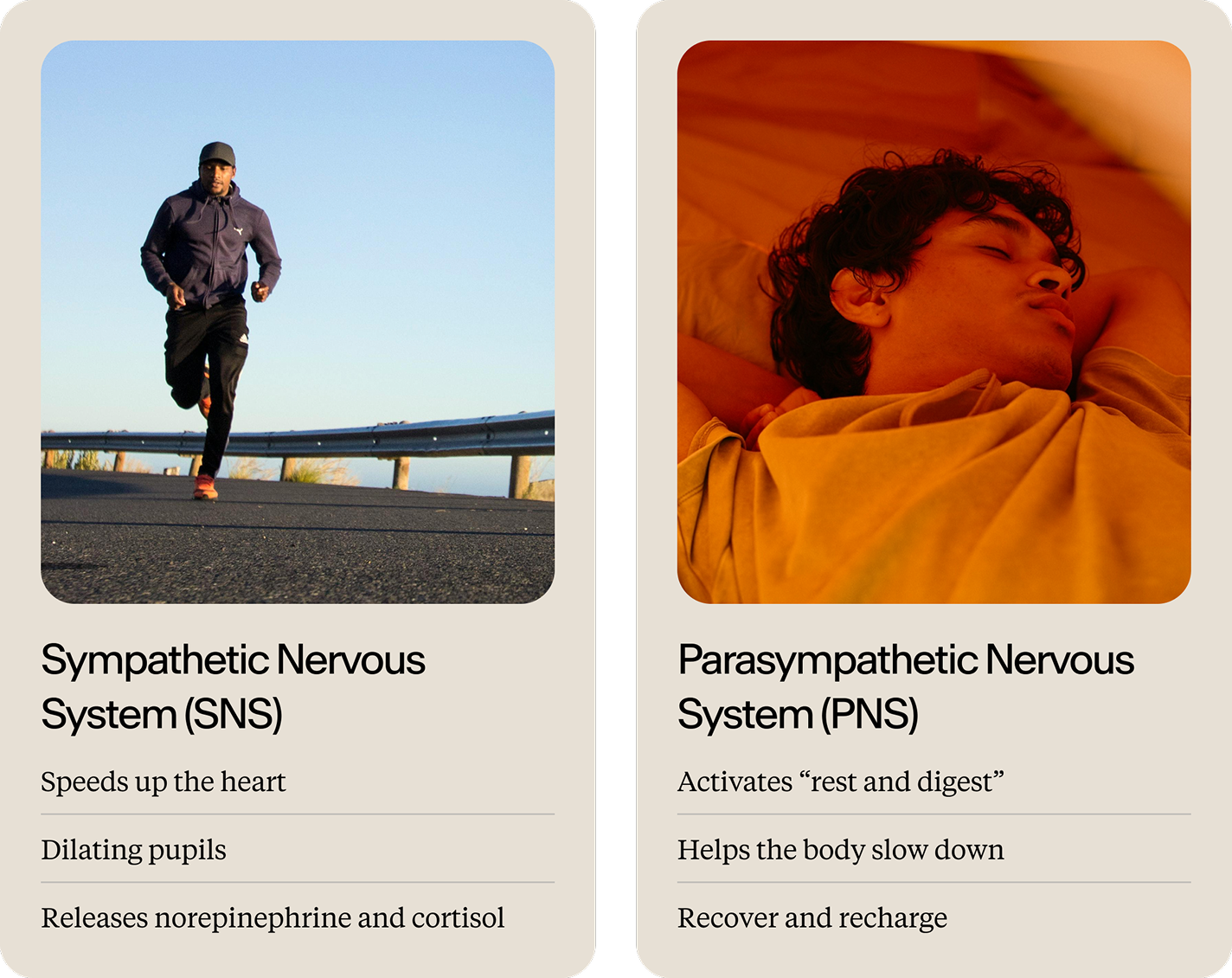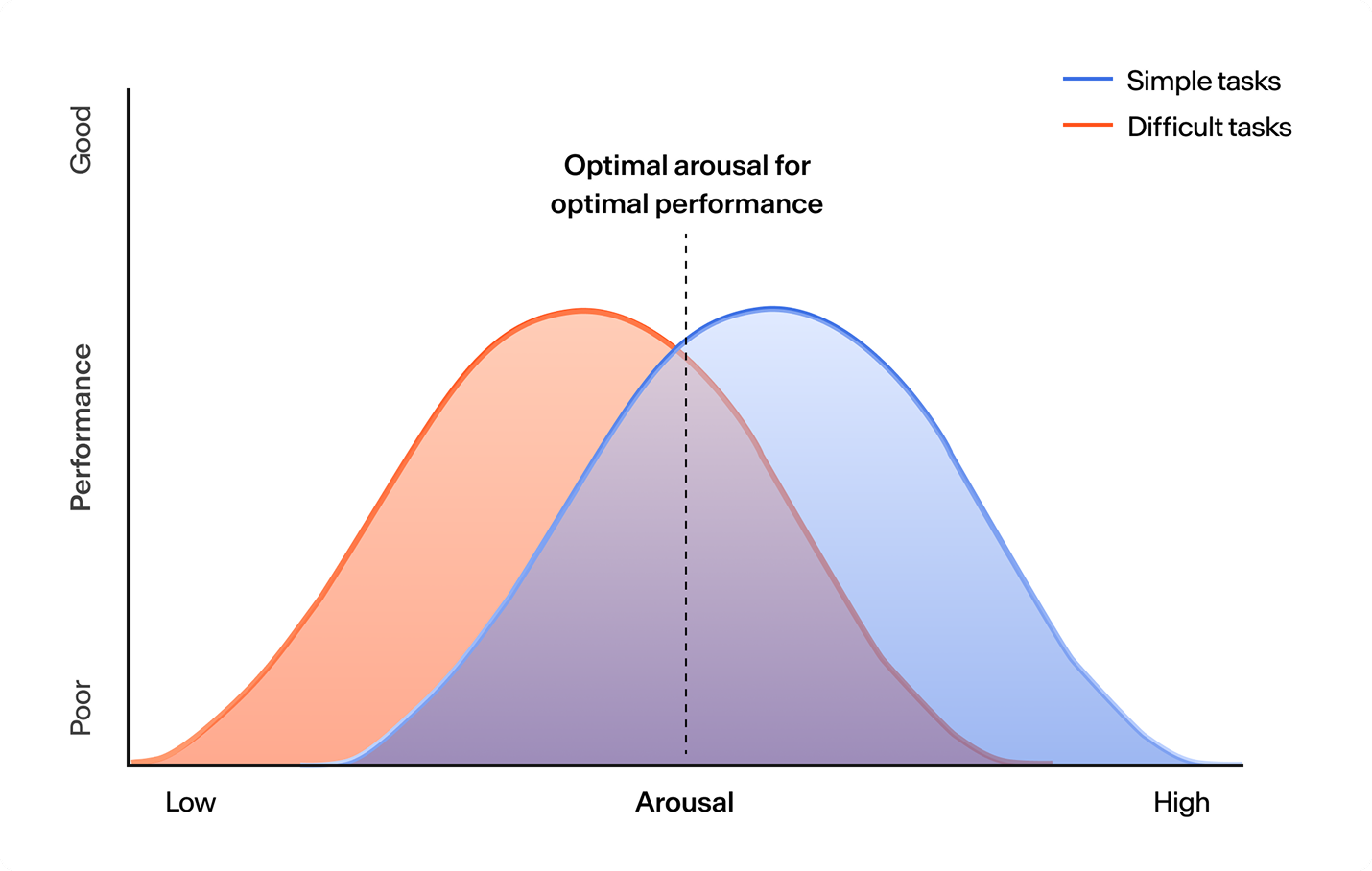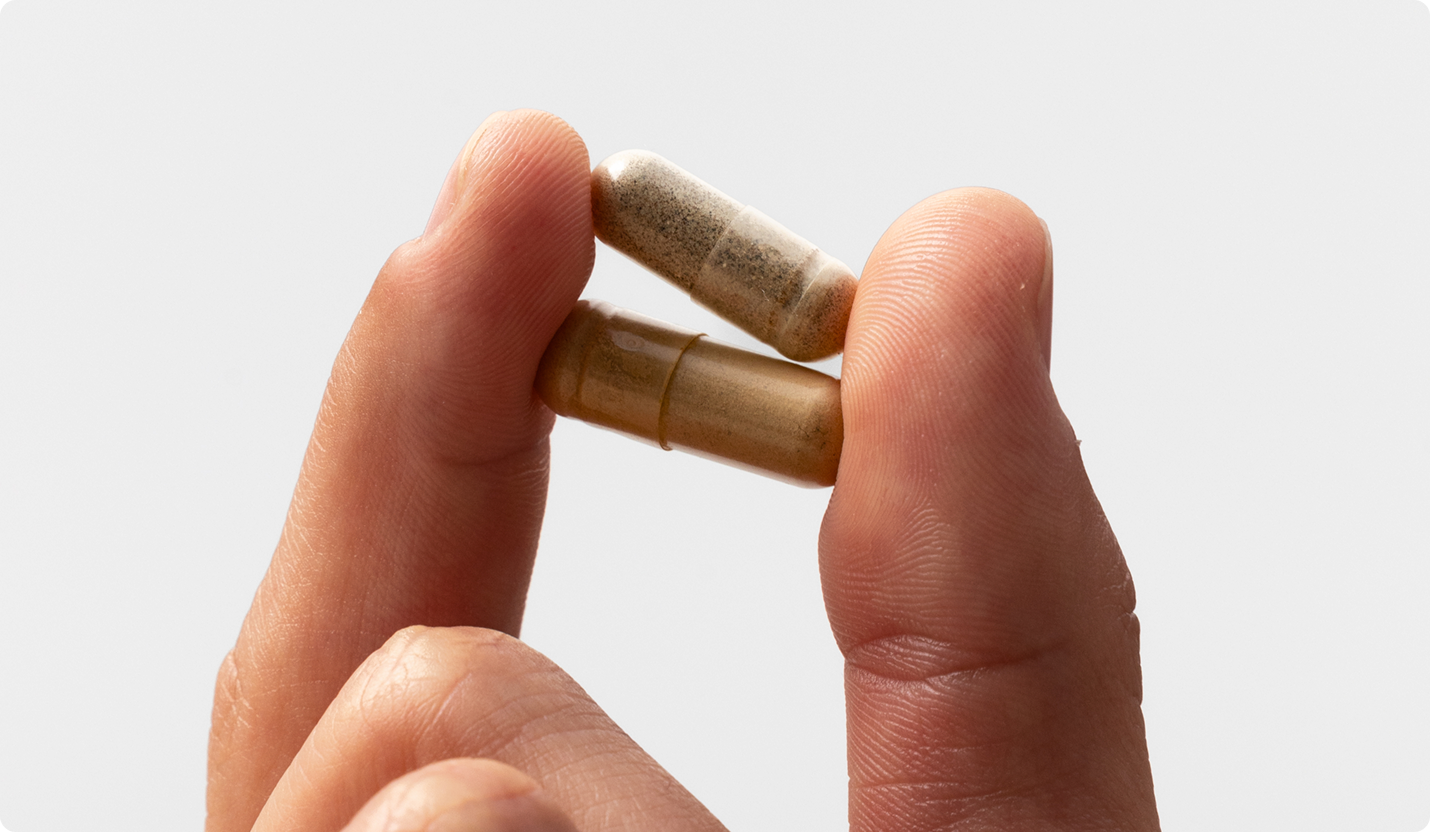Stimulants & the Overactive Sympathetic Nervous System
Exploring how stimulants can affect the autonomic nervous system–and the ingredients, habits, and tools that restore balance.
August 26, 2025

What is Your Nervous System and Why Does it Matter?
This information is for educational purposes only and is not intended as medical advice. Please consult a healthcare professional for any health concerns.
Your nervous system is like the mission control of your body.
It directs every move you make, every emotion you feel—whether it’s the buzz from a cold brew or the kick from stimulants. Though, the action isn’t limited to your brain: it’s behind the scenes in a network called the autonomic nervous system (ANS). Think of the ANS as your body’s autopilot that silently manages essential functions like your heart, lungs, digestion, and sleep without you even noticing.16, 17, 21
The ANS has two branches that work in dynamic balance:

1) Sympathetic Nervous System (SNS): Triggers the “fight or flight” response by increasing heart rate, dilating pupils, and releasing stress hormones like norepinephrine and cortisol.
2) Parasympathetic Nervous System (PNS): Activates “rest and digest” functions, helping the body slow down, recover, and recharge.
It’s worth remembering that the sympathetic nervous system isn’t the villain here—it’s an evolutionary advantage. For most of human history, quick bursts of “fight-or-flight” energy helped our ancestors hunt, escape danger, and respond to immediate threats by instantly redirecting blood flow to muscles, flooding the system with glucose for quick energy, and heightening sensory awareness—all within seconds. The challenge however, isn't that the SNS is flawed, but that our modern environment constantly triggers a system designed for occasional, acute threats. In the modern world, our SNS can be triggered by things our bodies treat like emergencies: traffic, deadlines, back-to-back meetings, constant notifications, even too much caffeine. The same mechanism that once helped us survive can now run on overdrive, creating stress where there’s no real danger – activating the same ancient pathways that once helped us escape saber-toothed tigers, but these modern triggers are chronic rather than episodic. Our biology hasn't caught up to our lifestyle.30
Think of cortisol as the headlining DJ at your body’s internal music festival. When stress hits, your brain activates the hypothalamic-pituitary-adrenal (HPA) axis, signaling the adrenal glands to release cortisol. This hormone boosts alertness and energy by engaging the SNS. Cortisol is part of a feedback loop: once the stressor passes, it signals the brain to slow things down and let the PNS take over so the body can rest and recover.14 When stress is constant however, cortisol overstays its welcome. The feedback loop breaks, the HPA axis gets dysregulated, and the nervous system stays stuck in high gear. Over time, this chronic activation impairs sleep, memory, mood, and immune function—like being trapped in a nonstop festival with no break in the music.31
Something you might not realize: Most stimulants–including caffeine–are classified as sympathomimetics, meaning they mimic or enhance SNS activity, which explain the heightened alertness and energy.3,22 Pushing your body into “super-alert” mode for a quick burst can feel amazing, but too much, too often? You can end up feeling like a phone stuck in perpetual vibrate: never fully “off,” and always a little keyed up. That’s when feelings of fatigue, mental cloudiness, irritability, and even burn out sneak in. Prescription stimulants work in similar ways, but mostly target central nervous system (CNS) pathways–offering short-term boosts in focus and energy, but potentially contributing to long-term CNS strain when not properly managed.35
The Physiological & Cognitive Toll of an Overactive SNS
While the SNS helps us respond to immediate challenges, chronic activation – whether it be by stimulants or sustained stress – can disrupt the body’s ability to rest, recover, and function optimally. This constant “fight-or-flight” mode affects physical, mental, and emotional health.
Mental Fatigue
Long-lasting SNS activation from sustained periods of mental workload elevates sympathetic activity (via heart rate variability) and suppresses parasympathetic function. Over time, this may affect cognitive function, particularly with prolonged stimulant use.36,19
Sleep Disturbances
Disrupted or insufficient sleep is strongly associated with sympathetic overactivity: elevated heart rate, metabolic rate, cortisol, and norepinephrine. Direct nerve measurements confirm exaggerated stress responses, worsened by stimulants like caffeine, which delay melatonin release.20
Irritability
Constant SNS activation amplifies amygdala-driven emotional reactivity while dampening prefrontal cortex regulation, heightening irritability. Stimulants worsen this imbalance, impairing stress recovery and emotional control.26
Trouble Relaxing
Persistent SNS dominance suppresses PNS activation, maintaining hyperarousal and impairing stress recovery, eventually impairing the ability to downregulate stress. For individuals taking stimulants regularly, this prolonged alert state can become habitual.7, 11
When the SNS Helps – and When It Hurts
When Arousal Hinders Performance: The idea that “more stimulation equals better performance” only holds true to a point. The Yerkes-Dodson Law explains that performance improves with arousal only up to an optimal threshold. Beyond this threshold, additional stimulation begins to undermine cognitive and emotional function.5, 8, 12, 33 For example, low-dose of a stimulant enhances arousal and cognitive performance by increasing prefrontal dopamine and norepinephrine efflux, but too high of a dose impairs flexibility and decision-making.1, 27, 28
Arousal and Performance: The Yerkes-Dodson Curve
Too little arousal = boredom, low motivation
Too much arousal = stress, overwhelm, errors

Match Arousal to Task Type
Tasks that need calm (low arousal):
1) Creative thinking - Requires openness and mental space
2) Problem-solving - Needs focus and adaptability
3) Interpersonal work - Demands empathy and patience
Tasks that benefit from energy (high arousal):
1) Emergency response - Fast, instinctive action
2) Physical performance - Power, speed, endurance
3) Repetitive tasks - Alertness and drive
Recovery Isn't Optional
To offset SNS overuse, we must support the PNS through rest, breathwork, nature, and reduced stimulant use. Balance–not constant stimulation–is key to sustained performance and well-being.4,13
Best Practices for Balancing the ANS

To support recovery, emotional regulation, and focus, it's important to intentionally activate the parasympathetic nervous system (PNS). These practices help alleviate overstimulation and promote calmness
Deep Breathing Exercises
Vagus Nerve Stimulation: Slow, intentional breathing activates the vagus nerve, which helps reduce blood pressure and heart rate. This parasympathetic response calms the nervous system and supports emotional regulation.25
The 5-5-7 Breath: Breathe in 5s, hold 5s, out 7s—activates the vagus nerve. It’s a method used by top athletes before big events.
Meditation
Increased Parasympathetic Tone: Regular meditation encourages a state of mental stillness, enhances parasympathetic activity, and supports emotional balance. It helps quiet mental chatter and lowers physiological stress.29
Yoga
Integrated Relaxation: Yoga blends breath control, physical movement, and mindfulness. This combination fosters relaxation and enhances autonomic nervous system balance by shifting the body toward a parasympathetic state.6, 32
Poses that open the chest and slow the breath help you switch from “fight or flight” to a more relaxed mode.
Nature Walks
Cortisol Reduction: Spending 20–30 minutes in nature significantly lowers cortisol levels, aiding in stress relief and autonomic balance.15
Just 20 minutes in a park can drop your stress hormones, helping your SNS calm down, and therefore allow for a boost of focus.
Parasympathomimetics
Supplemental Support: Certain supplements can mimic or enhance the effects of the parasympathetic nervous system. These support relaxation, reduce physiological stress, and improve mental clarity and sleep.9, 24
Even small shifts toward parasympathetic engagement can make a meaningful difference in mental clarity, sleep quality, and overall resilience.
Hack your system: Restore the Balance

While lifestyle approaches form the foundation of nervous system balance, targeted nutritional support can provide additional benefits. Here's how specific ingredients support these same pathways:
Nutritional Support from Stasis for Nervous System Balance
L-Theanine
L-Theanine is an amino acid found in tea leaves. Research shows it interacts with neurotransmitter systems including GABA, serotonin, and dopamine. These interactions are associated with promoting a calm, focused mental state and have been studied in relation to autonomic nervous system balance in everyday stress contexts.18
Vitamin B6
Vitamin B6 is a cofactor in the synthesis of key calming neurotransmitters, including GABA and serotonin. By supporting the production of these neurotransmitters, B6 contributes to a balanced nervous system response and may play a role in how the body handles occasional stress.34
Vitamin B12
Vitamin B12 supports the formation of myelin (the protective sheath around nerves) and is essential for proper nerve signaling. It has been studied for its involvement in supporting emotional well-being and maintaining a healthy stress response.23
Vitamin D3
Vitamin D3 has been shown to influence the expression of brain-derived neurotrophic factor (BDNF). Research suggests it may support stress resilience and help maintain balance within the autonomic nervous system under challenging conditions.2
Fermented Salidroside (SalidroPure®)
Fermented salidroside, a bioactive compound extracted from rhodiola rosea, has been examined for its potential to help the body adapt to physical and mental stress. Studies indicate that it may support mitochondrial efficiency and promote a sense of equilibrium during periods of heightened demand.37
UbiQsome® CoQ10
CoQ10 supports mitochondrial energy production, especially in high-demand tissues like the brain and heart. It has been studied for its role in supporting cellular energy and supporting the nervous system to maintain balance during periods of increased demand.10
Key Study Summaries
The following information is for educational purposes only and is not intended as medical advice. These statements have not been evaluated by the Food and Drug Administration. This information is not intended to diagnose, treat, cure, or prevent any disease, nor is it intended to promote any specific product.
Caffeine, Arousal, and Task Difficulty
A double-blind, placebo-controlled study found that caffeine slightly improved performance on low memory load tasks but impaired accuracy on high memory load tasks (0.81 vs. 0.89 with placebo). Highly impulsive individuals were more sensitive to task order and complexity, suggesting increased arousal vulnerability. These results support the idea that while moderate arousal can enhance focus, excessive stimulation hinders performance–especially for complex tasks.3
Mindfulness and Physical Exercise as Non-Pharmacologic Modulators of SNS Activity
Emerging evidence supports the use of mindfulness-based interventions and structured physical exercise to modulate sympathetic activity. Mindfulness training, which teaches present-moment awareness and acceptance, and aerobic exercise both appear to improve cognitive performance and may reduce inflammation or directly influence neurotransmission.30
Mindfulness Meditation Resets Autonomic Balance
A 2024 systematic review found that Mindfulness-Based Stress Reduction (MBSR) increases cortical thickness in brain regions linked to emotional regulation (e.g., insula) while reducing amygdala reactivity. This neuroplasticity improves baroreflex sensitivity, shifting autonomic balance toward parasympathetic dominance. Participants showed a 22% reduction in muscle sympathetic nerve activity (MSNA) after 8 weeks of practice, with effects persisting during cognitive challenges.6
-
Citations:
- Advokat, C., & Scheithauer, M. (2013). Attention-deficit hyperactivity disorder (ADHD) stimulant medications as cognitive enhancers. Frontiers in Neuroscience, 7(82). https://doi.org/10.3389/fnins.2013.00082
- Akpınar, Ş., & Karadağ, M. G. (2022). Is Vitamin D Important in Anxiety or Depression? What Is the Truth? Current Nutrition Reports, 11(4). https://doi.org/10.1007/s13668-022-00441-0
- Anderson, K. J. (1994). Impulsitivity, caffeine, and task difficulty: A within-subjects test of the Yerkes-Dodson law. Personality and Individual Differences, 16(6), 813–829. https://doi.org/10.1016/0191-8869(94)90226-7
- Berridge, C. W. (2006). Neural Substrates of Psychostimulant-Induced Arousal. Neuropsychopharmacology, 31(11), 2332–2340. https://doi.org/10.1038/sj.npp.1301159
- Calabrese, E. J. (2008). Stress Biology and Hormesis: The Yerkes–Dodson Law in Psychology—A Special Case of the Hormesis Dose Response. Critical Reviews in Toxicology, 38(5), 453–462. https://doi.org/10.1080/10408440802004007
- Calderone, A., Latella, D., Impellizzeri, F., Pasquale, P. de, Famà, F., Quartarone, A., & Calabrò, R. S. (2024). Neurobiological Changes Induced by Mindfulness and Meditation: A Systematic Review. Biomedicines, 12(11), 2613–2613. https://doi.org/10.3390/biomedicines12112613
- Daniela, M., Catalina, L., Ilie, O., Paula, M., Daniel-Andrei, I., & Ioana, B. (2022). Effects of Exercise Training on the Autonomic Nervous System with a Focus on Anti-Inflammatory and Antioxidants Effects. Antioxidants (Basel, Switzerland), 11(2), 350. https://doi.org/10.3390/antiox11020350
- Faller, J., Cummings, J., Saproo, S., & Sajda, P. (2019). Regulation of arousal via online neurofeedback improves human performance in a demanding sensory-motor task. Proceedings of the National Academy of Sciences, 116(13), 6482–6490. https://doi.org/10.1073/pnas.1817207116
- Forrester, J. V., Dick, A. D., McMenamin, P. G., Roberts, F., & Pearlman, E. (2016). General and ocular pharmacology. The Eye, 338-369.e1. https://doi.org/10.1016/b978-0-7020-5554-6.00006-x
- Fukuda, S., Nojima, J., Kajimoto, O., Yamaguti, K., Nakatomi, Y., Kuratsune, H., & Watanabe, Y. (2016). Ubiquinol-10 supplementation improves autonomic nervous function and cognitive function in chronic fatigue syndrome. BioFactors (Oxford, England), 42(4), 431–440. https://doi.org/10.1002/biof.1293
- Gerritsen, R. J. S., & Band, G. P. H. (2018). Breath of Life: The Respiratory Vagal Stimulation Model of Contemplative Activity. Frontiers in Human Neuroscience, 12(12). https://doi.org/10.3389/fnhum.2018.00397
- Gjedde, A., Kumakura, Y., Cumming, P., Linnet, J., & Møller, A. (2010). Inverted-U-shaped correlation between dopamine receptor availability in striatum and sensation seeking. Proceedings of the National Academy of Sciences, 107(8), 3870–3875. https://doi.org/10.1073/pnas.0912319107
- Han, L., Liu, Y., Zhang, D., Jin, Y., & Luo, Y. (2013). Low-Arousal Speech Noise Improves Performance in N-Back Task: An ERP Study. PLoS ONE, 8(10), e76261. https://doi.org/10.1371/journal.pone.0076261
- Herman, J. P., McKlveen, J. M., Ghosal, S., Kopp, B., Wulsin, A., Makinson, R., Scheimann, J., & Myers, B. (2016). Regulation of the Hypothalamic-Pituitary-Adrenocortical Stress Response. Comprehensive Physiology, 6(2), 603–621. https://doi.org/10.1002/cphy.c150015
- Hunter, M. C. R., Gillespie, B. W., & Chen, S. Y.-P. (2019). Urban Nature Experiences Reduce Stress in the Context of Daily Life Based on Salivary Biomarkers. Frontiers in Psychology, 10(1). https://doi.org/10.3389/fpsyg.2019.00722
- Jänig, W. (2006). The integrative action of the autonomic nervous system. Cambridge University Press. https://doi.org/10.1017/CBO9780511541667
- Kandel, E. R., Koester, J. D., Mack, S. H., & Siegelbaum, S. A. (Eds.). (2021). Principles of neural science (6th ed.). McGraw Hill. https://accessbiomedicalscience.mhmedical.com/content.aspx?bookid=3024§ionid=254326744
- Kimura, K., Ozeki, M., Juneja, L. R., & Ohira, H. (2007). L-Theanine reduces psychological and physiological stress responses. Biological Psychology, 74(1), 39–45. https://doi.org/10.1016/j.biopsycho.2006.06.006
- Kunasegaran, K., Ismail, A. M. H., Ramasamy, S., Gnanou, J. V., Caszo, B. A., & Chen, P. L. (2023). Understanding mental fatigue and its detection: a comparative analysis of assessments and tools. PeerJ, 11(1), e15744. https://doi.org/10.7717/peerj.15744
- López-Cano, C., Gutiérrez-Carrasquilla, L., Sánchez, E., González, J., Yeramian, A., Martí, R., Hernández, M., Cao, G., Ribelles, M., Gómez, X., Barril, S., Barbé, F., Hernández, C., Simó, R., & Lecube, A. (2019). Sympathetic Hyperactivity and Sleep Disorders in Individuals With Type 2 Diabetes. Frontiers in Endocrinology, 10. https://doi.org/10.3389/fendo.2019.00752
- McCorry, L. K. (2007). Physiology of the autonomic nervous system. American Journal of Pharmaceutical Education, 71(4), 78. https://doi.org/10.5688/aj710478
- McLellan, T. M., Caldwell, J. A., & Lieberman, H. R. (2016). A review of caffeine’s effects on cognitive, physical and occupational performance. Neuroscience & Biobehavioral Reviews, 71(1), 294–312. https://doi.org/10.1016/j.neubiorev.2016.09.001
- Nishimoto, S., Tanaka, H., Okamoto, M., Okada, K., Murase, T., & Yoshikawa, H. (2015). Methylcobalamin promotes the differentiation of Schwann cells and remyelination in lysophosphatidylcholine-induced demyelination of the rat sciatic nerve. Frontiers in Cellular Neuroscience, 9. https://doi.org/10.3389/fncel.2015.00298
- Palma, J.-A., & Thijs, R. D. (2023). Non-Pharmacological Treatment of Autonomic Dysfunction in Parkinson’s Disease and Other Synucleinopathies. Journal of Parkinson’s Disease, Preprint(Preprint), 1–12. https://doi.org/10.3233/JPD-230173
- Pérez-Alcalde, A. I., Galán-del-Río, F., Fernández-Rodríguez, F. J., de la Plaza San Frutos, M., García-Arrabé, M., Giménez, M.-J., & Ruiz-Ruiz, B. (2024). The Effects of a Single Vagus Nerve’s Neurodynamics on Heart Rate Variability in Chronic Stress: A Randomized Controlled Trial. Sensors, 24(21), 6874. https://doi.org/10.3390/s24216874
- Pongratz, G., & Straub, R. H. (2023). Chronic Effects of the Sympathetic Nervous System in Inflammatory Models. Neuroimmunomodulation, 30(1), 113–134. https://doi.org/10.1159/000530969
- Rozenek, E. B., Górska, M., Wilczyńska, K., & Waszkiewicz, N. (2019). In search of optimal psychoactivation: stimulants as cognitive performance enhancers. Archives of Industrial Hygiene and Toxicology, 70(3), 150–159. https://doi.org/10.2478/aiht-2019-70-3298
- Saman Khazaei, Md Rafiul Amin, Tahir, M., & Faghih, R. T. (2024). Bayesian Inference of Hidden Cognitive Performance and Arousal States in Presence of Music. IEEE Open Journal of Engineering in Medicine and Biology, 1–10. https://doi.org/10.1109/ojemb.2024.3377923
- Sezer, I., & Sacchet, M. D. (2025). Advanced and long-term meditation and the autonomic nervous system: A review and synthesis. Neuroscience & Biobehavioral Reviews, 173, 106141. https://doi.org/10.1016/j.neubiorev.2025.106141
- Sibley, M. H., Bruton, A. M., Zhao, X., Johnstone, J. M., Mitchell, J., Hatsu, I., Arnold, L. E., Basu, H. H., Levy, L., Vyas, P., Macphee, F., Gonzalez, E. S., Kelley, M., Jusko, M. L., Bolden, C. R., Zulauf-McCurdy, C., Manzano, M., & Torres, G. (2023). Non-pharmacological interventions for attention-deficit hyperactivity disorder in children and adolescents. The Lancet Child & Adolescent Health, 7(6). https://doi.org/10.1016/S2352-4642(22)00381-9
- Smith, S., & Vale, W. (2006). The role of the hypothalamic-pituitary-adrenal axis in neuroendocrine responses to stress. Dialogues in Clinical Neuroscience, 8(4). https://doi.org/10.31887/dcns.2006.8.4
- Sneha, K., & Mahantha, M. (2019). Effect of yoga on parasympathetic nervous system of human body. Indian Journal of Clinical Anatomy and Physiology, 6(4), 492–496. https://doi.org/10.18231/j.ijcap.2019.108
- Sörensen, L. K. A., Bohté, S. M., Slagter, H. A., & Scholte, H. S. (2022). Arousal state affects perceptual decision-making by modulating hierarchical sensory processing in a large-scale visual system model. PLOS Computational Biology, 18(4), e1009976. https://doi.org/10.1371/journal.pcbi.1009976
- Vikram Babu Kasaragod, Pacios-Michelena, A., Schaefer, N., Zheng, F., Bader, N., Alzheimer, C., Villmann, C., & Hermann Schindelin. (2020). Pyridoxal kinase inhibition by artemisinins down-regulates inhibitory neurotransmission. Proceedings of the National Academy of Sciences, 117(52), 33235–33245. https://doi.org/10.1073/pnas.2008695117
- Volkow, N. D., Koob, G. F., Croyle, R. T., Bianchi, D. W., Gordon, J. A., Koroshetz, W. J., Pérez-Stable, E. J., Riley, W. T., Bloch, M. H., Conway, K., Deeds, B. G., Dowling, G. J., Grant, S., Howlett, K. D., Matochik, J. A., Morgan, G. D., Murray, M. M., Noronha, A., Spong, C. Y., & Wargo, E. M. (2018). The conception of the ABCD study: From substance use to a broad NIH collaboration. Developmental Cognitive Neuroscience, 32, 4–7. https://doi.org/10.1016/j.dcn.2017.10.002
- Wenner, M. M. (2018). Sympathetic activation in chronic anxiety: not just at the “height” of stress. Editorial Focus on “Relative burst amplitude of muscle sympathetic nerve activity is an indicator of altered sympathetic outflow in chronic anxiety.” Journal of Neurophysiology, 120(1), 7–8. https://doi.org/10.1152/jn.00220.2018
- Zhong, Z., Han, J., Zhang, J., Xiao, Q., Hu, J., & Chen, L. (2018). Pharmacological activities, mechanisms of action, and safety of salidroside in the central nervous system. Drug Design, Development and Therapy, 12, 1479–1489. https://doi.org/10.2147/DDDT.S160776
